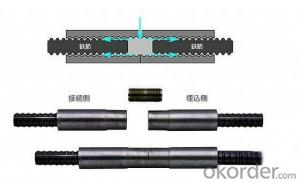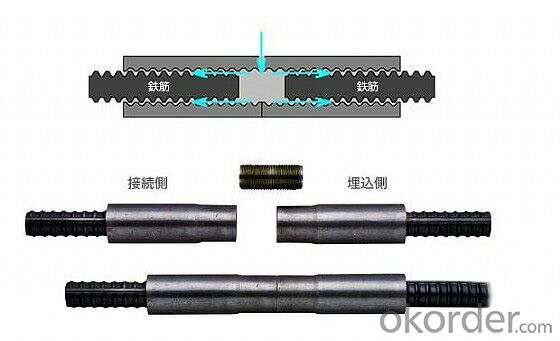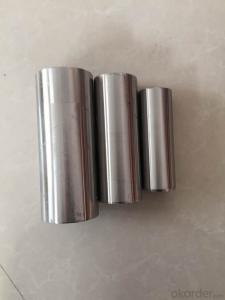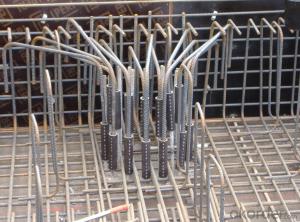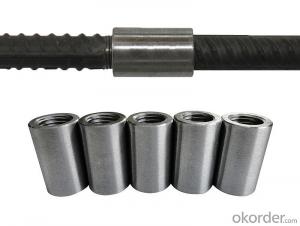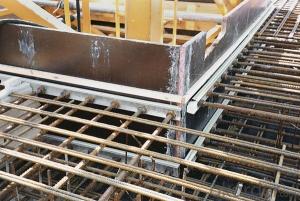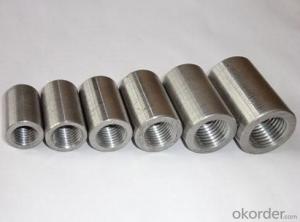Steel Coupler Rebar Scaffolding In Dubai Wedge Lock Scaffolding
- Loading Port:
- Shanghai
- Payment Terms:
- TT OR LC
- Min Order Qty:
- 1000 pc
- Supply Capability:
- 10000000 pc/month
OKorder Service Pledge
OKorder Financial Service
You Might Also Like
Steel Coupler Rebar Scaffolding In Dubai Wedge Lock Scaffolding
1.Description:
Lapped joints are not always an appropriate means of connecting rebar. The use of Steel Rebar Couplers can simplify the design and construction of reinforced concrete and reduce the amount of reinforcement required.
The threaded steel coupler system is designed as a threaded reinforcement connection with 100% load transmission. The steel coupler rebar connection system is suitable for both static and dynamic load transmission in construction joints.
The coupler is designed as a threaded reinforcement connection for formed construction joints. Reinforcement work is normally carried out on both sides of the construction joint using lap joints or one side is anchored. The bar lengths are based on the structural analysis requirements of the building component and are calculated from anchorage and lap lengths.
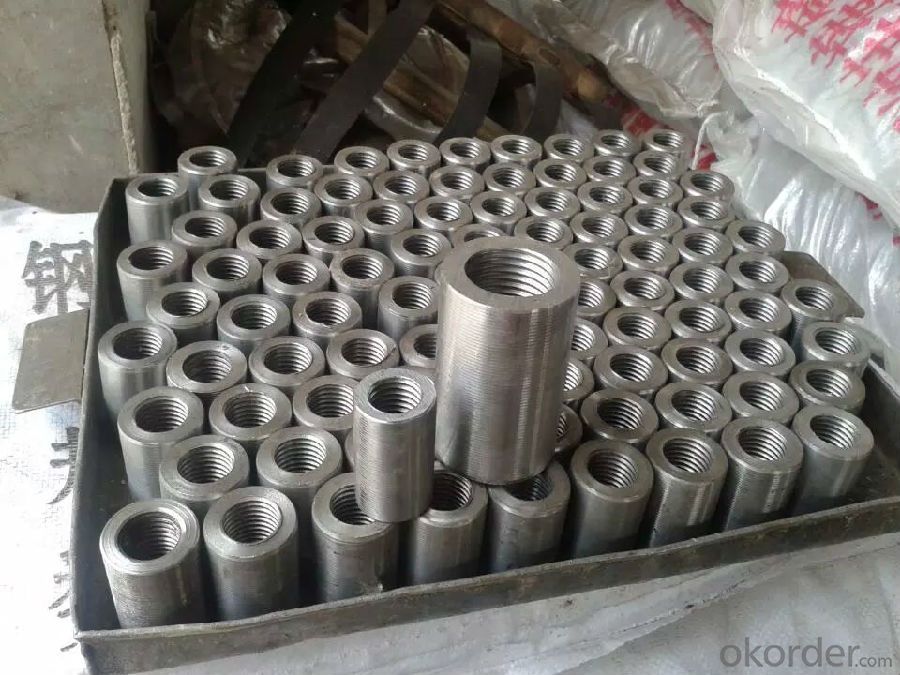

2.Advantages of Steel Coupler Rebar Lift Scaffolding Galvanized Scaffolding Tube with Low Price:
The coupler system provides the opportunity to connect rebars quickly, easily and cost effectively, even when large rebar diameters are used. This makes the steel coupler rebar range a logical extension to our rebendable CNBM reinforcement continuity system for rebars over 12 mm.
3.Available sizes of Steel Coupler Rebar Lift Scaffolding Galvanized Scaffolding Tube with Low Price:
14mm,16mm,18mm,20mm,22mmm,25mm,28mm,32mm,36mm,40mm
4.Delivery:
Delivery Term: FOB / CFR / CIF available.
Delivery Time: 15 days or less after order confirmed.
5.Why choose us?
Technical Expertise
Experienced Management
Stringent Quality Control
Exemplary Service
On-Time Delivery
Wide Product Range
Competitive Pricing
Huge branch network capable of catering worldwide
- Q: Can steel formwork be used for both straight and curved concrete elements?
- Yes, steel formwork can be used for both straight and curved concrete elements. Steel formwork is highly versatile and can be easily adapted to different shapes and sizes. It provides a strong and durable framework that can withstand the pressure of the concrete, allowing for the creation of both straight and curved structures.
- Q: How does steel formwork affect the overall sound insulation of a building?
- The overall sound insulation of a building is not directly affected by steel formwork. The quality and design of the walls, floors, and ceilings are the main factors that determine sound insulation, regardless of the formwork material used. However, sound insulation may be indirectly influenced by steel formwork during the construction phase. Steel formwork is renowned for its rigidity and strength, which ensures precise and accurate pouring of concrete. This precise construction technique helps minimize gaps and imperfections that can occur during the concrete casting process. Consequently, steel formwork contributes to creating a smoother and more uniform concrete surface, reducing the possibility of sound leakage through cracks or joints. Additionally, steel formwork can be employed to create even and smooth surfaces, facilitating the installation of soundproofing materials like acoustic panels or insulation. These supplementary soundproofing measures, when incorporated during construction, can enhance the overall sound insulation of the building. It is important to recognize that although steel formwork can indirectly impact sound insulation during construction, the primary elements affecting sound insulation are the materials and techniques utilized in constructing walls, floors, and ceilings. Architectural design, insulation materials, and sealing techniques all play a crucial role in achieving optimal sound insulation levels.
- Q: Can steel formwork be used for both small and large concrete pours?
- Steel formwork is applicable for concrete pours of various sizes and dimensions. Its adaptability allows for easy adjustment and modification to accommodate diverse concrete structures. Its robustness and stability make it suitable for extensive pours that entail substantial weights and pressures. Moreover, the reusability of steel formwork renders it an economically viable choice for construction projects, regardless of their scale.
- Q: Are there any environmental considerations when using steel formwork?
- Using steel formwork in construction projects raises several environmental considerations. First and foremost, the production of steel leaves a significant carbon footprint. Greenhouse gas emissions are generated during the extraction and processing of raw materials, such as iron ore and coal. Moreover, the manufacturing process itself requires a substantial amount of energy, further contributing to carbon emissions. In addition, the transportation of steel formwork systems has a negative environmental impact. The movement of heavy steel panels and other components increases fuel consumption and emissions, particularly for long distances. Furthermore, steel formwork is typically non-renewable and non-recyclable. Once it reaches the end of its useful life, it often ends up in landfills, contributing to waste accumulation and environmental pollution. However, it is important to note that steel formwork does have some environmental advantages compared to other materials. For instance, it can be reused multiple times, reducing the need for new materials and minimizing waste generation. Its durability and strength also contribute to a longer lifespan and less frequent replacements, which in turn reduces overall resource consumption. To mitigate the environmental impact of using steel formwork, various measures can be taken. These include optimizing transportation routes to reduce fuel consumption, implementing energy-efficient manufacturing processes, and promoting the recycling of steel formwork components at the end of their life. Additionally, exploring alternative formwork materials, such as recycled or sustainable options, can also help address the environmental considerations associated with steel formwork usage.
- Q: Can steel formwork be used for structures with high seismic resistance requirements?
- Yes, steel formwork can be used for structures with high seismic resistance requirements. Steel is a strong and durable material that can withstand the stresses and vibrations caused by seismic activity. It provides excellent stability and structural integrity, making it suitable for constructing buildings that need to withstand earthquakes and other seismic events. Additionally, steel formwork allows for precise construction and easy removal, making it a practical choice for projects that require efficient and reliable seismic-resistant structures.
- Q: How does steel formwork affect the overall construction site safety measures?
- The overall construction site safety measures can be significantly impacted by steel formwork in various ways. To start with, the high strength and durability of steel formwork ensure stability and structural integrity during construction, thus reducing the risk of accidents like collapses or structural failures. This, in turn, enhances the safety of workers and the entire site. Moreover, steel formwork offers superior fire resistance compared to other formwork materials. This characteristic helps prevent or slow down the spread of fire, allowing workers enough time to evacuate the site safely and enabling emergency services to respond effectively. It also decreases the chances of fire-related accidents, safeguarding both human lives and the surrounding environment. Another safety advantage of steel formwork lies in its ability to withstand extreme weather conditions such as strong winds or heavy rain. This resilience lowers the likelihood of formwork damage or failure, ensuring worker safety and preventing potential accidents caused by adverse weather. Furthermore, steel formwork is often designed with integrated safety features like handrails and platforms to provide secure working surfaces for construction workers. These features enable workers to perform their tasks safely at heights, reducing the risk of falls and injuries. Lastly, steel formwork is reusable and requires minimal maintenance, contributing to overall site safety. The use of reusable formwork minimizes waste and clutter, resulting in a cleaner and more organized working environment. This, in turn, reduces the risk of accidents caused by tripping or falling over debris. In conclusion, steel formwork positively impacts construction site safety measures by providing stability, fire resistance, weather resistance, built-in safety features, and a cleaner working environment. These benefits reduce the risk of accidents, ensure worker safety, and contribute to the successful completion of construction projects.
- Q: How does steel formwork handle different concrete durability requirements?
- Steel formwork is highly versatile and can easily handle different concrete durability requirements. It provides a reliable and durable framework for concrete casting, ensuring consistent and precise results. Steel formwork can withstand the pressure of fresh concrete without deforming, which is essential for achieving the desired shape and finish of the concrete structure. Additionally, steel formwork can be easily adjusted and reused, making it suitable for various construction projects with different durability requirements. Whether the concrete needs to withstand heavy loads, extreme weather conditions, or have a longer service life, steel formwork can efficiently accommodate these requirements and help in achieving the desired durability of the concrete structure.
- Q: How does steel formwork compare to timber formwork?
- Construction projects often prefer steel formwork over timber formwork for several reasons. Firstly, steel formwork is highly durable and long-lasting compared to timber formwork. Steel is a resilient material that can withstand heavy loads and harsh weather, making it ideal for multiple uses and reducing the need for frequent replacements. In terms of strength, steel formwork provides greater structural integrity and stability. It can handle higher concrete pressures, allowing for the construction of taller and more complex structures. This is particularly advantageous for high-rise buildings or projects that require large spans. Steel formwork also offers superior dimensional accuracy and consistency. Unlike timber, it does not warp or distort over time, ensuring that the final concrete structure maintains its intended shape and dimensions. This saves time and effort during construction, as fewer adjustments or corrections are necessary. Moreover, steel formwork is easier to clean and maintain. It does not absorb moisture or attract pests like timber does, reducing the risk of deterioration or contamination. Additionally, steel formwork can be easily reused multiple times, making it a more sustainable and cost-effective option in the long run. However, it is important to note that steel formwork generally requires more specialized equipment and skilled labor for assembly and disassembly compared to timber formwork. This may result in higher initial costs and longer setup times for projects. Furthermore, steel formwork may not be suitable for certain applications where weight is a concern, as it is generally heavier than timber. Overall, while both steel and timber formwork have their pros and cons, steel formwork is often preferred in construction due to its durability, strength, dimensional accuracy, and ease of maintenance.
- Q: Can steel formwork be used for underground structures?
- Indeed, steel formwork can be utilized for underground structures. An adaptable and long-lasting choice, steel formwork proves ideal for the creation of underground structures, including basements, tunnels, and underground storage facilities. Its exceptional strength and stability enable it to withstand the pressure and burdens related to underground construction. Steel formwork establishes a firm framework for pouring concrete, guaranteeing proper shaping and alignment of the structure. Its capacity to endure high pressures and forces permits the construction of robust and enduring underground structures, capable of withstanding the surrounding soil and water pressure. Moreover, steel formwork is reusable, rendering it an economically advantageous option for underground construction projects. Effortless dismantling, cleaning, and future utilization contribute to reduced costs and environmental impact. Furthermore, steel formwork facilitates efficient construction processes and expedites completion times. Its modular nature allows for swift assembly and disassembly, saving time and labor compared to traditional formwork methods. Nevertheless, prior to employing steel formwork, it is crucial to consider the specific requirements and conditions of the underground structure. Factors such as soil conditions, water table levels, and the intended use of the structure should undergo evaluation to ensure that steel formwork is the most appropriate choice. Professional engineering expertise and comprehensive planning are essential for the successful implementation of steel formwork in underground construction projects.
- Q: Can steel formwork be used in areas with high wind loads?
- Areas with high wind loads can utilize steel formwork. Steel formwork is renowned for its strength, durability, and stability, making it an ideal choice for construction projects in such areas. The robustness and rigidity of steel formwork enable it to withstand the immense force and pressure exerted by strong winds, ensuring the safety and stability of the structure under construction. Moreover, compared to other formwork materials, steel formwork offers a superior level of resistance to deformation and movement, rendering it more dependable in areas prone to high wind loads. Nonetheless, it is imperative to properly secure and anchor the steel formwork to the ground to further enhance its resistance against wind loads.
Send your message to us
Steel Coupler Rebar Scaffolding In Dubai Wedge Lock Scaffolding
- Loading Port:
- Shanghai
- Payment Terms:
- TT OR LC
- Min Order Qty:
- 1000 pc
- Supply Capability:
- 10000000 pc/month
OKorder Service Pledge
OKorder Financial Service
Similar products
Hot products
Hot Searches
Related keywords
